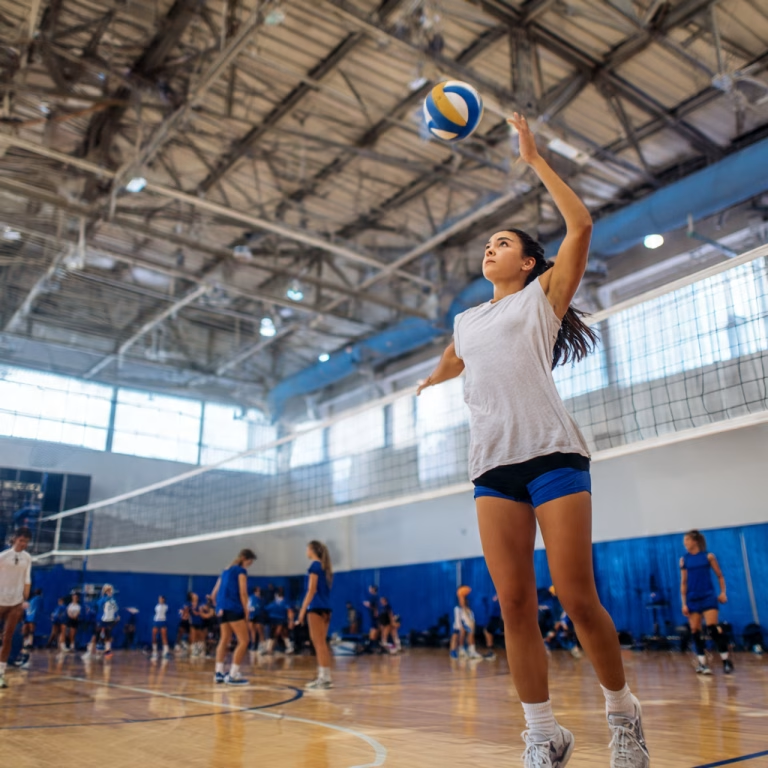Imagine the final moments of a thrilling volleyball match. The score is tied, tension fills the air, and the opposing team is setting up for a powerful spike. In this high-stakes moment, one of the most critical factors in the game comes into play—the height of the volleyball net. Whether you’re an aspiring player, a coach, or simply a fan of the sport, understanding the exact height of a volleyball net and its significance can enhance your appreciation and performance in the game.
Official Volleyball Net Heights
The height of a volleyball net varies based on several factors, including the level of play, gender, and age group. The official net height is set by the Fédération Internationale de Volleyball (FIVB) and other governing bodies such as the National Collegiate Athletic Association (NCAA) and the United States Volleyball Association (USAV).
Standard Net Heights:
- Men’s Volleyball: 2.43 meters (7 feet, 11 5/8 inches)
- Women’s Volleyball: 2.24 meters (7 feet, 4 1/8 inches)
- Co-Ed Volleyball: Usually follows the men’s height at 2.43 meters
- Sitting Volleyball: 1.15 meters (3 feet, 9.28 inches) for men and 1.05 meters (3 feet, 5.34 inches) for women
Net Heights for Different Age Groups
Younger players and special divisions often use modified net heights to accommodate different skill levels and physical abilities:
- Boys Under 14: 2.24 meters (7 feet, 4 1/8 inches)
- Girls Under 14: 2.13 meters (7 feet)
- Boys Under 12 & Girls Under 12: 2.13 meters (7 feet)
- Youth Volleyball (ages 10 and under): 1.98 meters (6 feet, 6 inches)
These adjustments ensure that younger athletes develop proper skills and techniques without being hindered by an excessively high net.
Why Does Net Height Matter?
The height of a volleyball net affects nearly every aspect of the game. From spiking and blocking to serving and setting, here’s why net height is crucial:
1. Influences Gameplay Strategies
A higher net makes it more challenging to spike the ball effectively, requiring more skill, strength, and vertical leap. Conversely, a lower net allows for easier attacking and faster-paced play.
2. Affects Blocking and Defense
Blocking against a spike becomes significantly harder when the net is high, requiring taller players or those with exceptional jumping ability. Defensive strategies must be adjusted accordingly based on net height.
3. Encourages Skill Development
For younger players, using a lower net fosters better fundamentals such as proper serving, setting, and hitting techniques before progressing to higher levels.
Indoor vs. Beach Volleyball Net Heights
While indoor and beach volleyball follow similar height regulations, there are subtle differences based on playing conditions and governing rules:
- Men’s Beach Volleyball: 2.43 meters (7 feet, 11 5/8 inches)
- Women’s Beach Volleyball: 2.24 meters (7 feet, 4 1/8 inches)
- Co-Ed Beach Volleyball: Typically follows the men’s height
Beach volleyball is played on a softer surface (sand), making jumping more challenging. Despite the identical net height to indoor volleyball, the playing dynamics differ due to the outdoor environment and smaller court size.
Measuring the Volleyball Net Height Correctly
To ensure fairness and accuracy, officials measure the net height before a match begins. Here’s how it’s done:
- Use a Measuring Tape: Place the measuring tape at the center of the net, extending it to the ground.
- Check Side Heights: The height should not vary by more than 2 cm (0.8 inches) from the official standard at the net’s ends.
- Account for Sagging: A net that sags too much in the middle is adjusted using the side poles and tension straps.
Adjustments for Recreational Play
In casual and recreational games, players often modify the net height based on comfort and skill level. Here are some common variations:
- Lowering the Net for Beginners: Helps newcomers develop their skills without frustration.
- Higher Nets for Advanced Players: Some groups choose to increase the net height for a greater challenge.
- Adjustments for Mixed-Gender Teams: Some leagues find a balance between men’s and women’s official heights.
Impact of Net Height on Different Playing Positions
Each position in volleyball is affected differently by the net’s height:
- Setters: A higher net may require setters to adjust their ball trajectory to accommodate stronger attacks.
- Hitters: Taller nets make it tougher to score points with spikes, requiring precise timing and jump height.
- Liberos & Defensive Players: Net height impacts the way digs and receives are executed, particularly when facing aggressive spikes.
Common Net Height Mistakes and How to Avoid Them
1. Not Measuring Before a Game
Many amateur and even some competitive games begin without verifying net height, leading to potential discrepancies.
2. Improper Net Tension
A loose net can disrupt play by absorbing too much energy from the ball or causing unpredictable rebounds.
3. Ignoring Age-Specific Regulations
When hosting youth tournaments, it’s crucial to adjust the net height according to official guidelines to maintain fairness.
The height of a volleyball net is more than just a technical specification—it’s a fundamental aspect of the game that affects skill development, strategy, and overall enjoyment. Whether you’re playing at a professional level, in a school league, or just for fun at the beach, knowing the correct net height and its impact can help you play more effectively.
Next time you step onto the court, take a moment to appreciate the net—it’s more than just a barrier; it’s the defining element that makes volleyball the fast-paced and exhilarating sport that it is!




